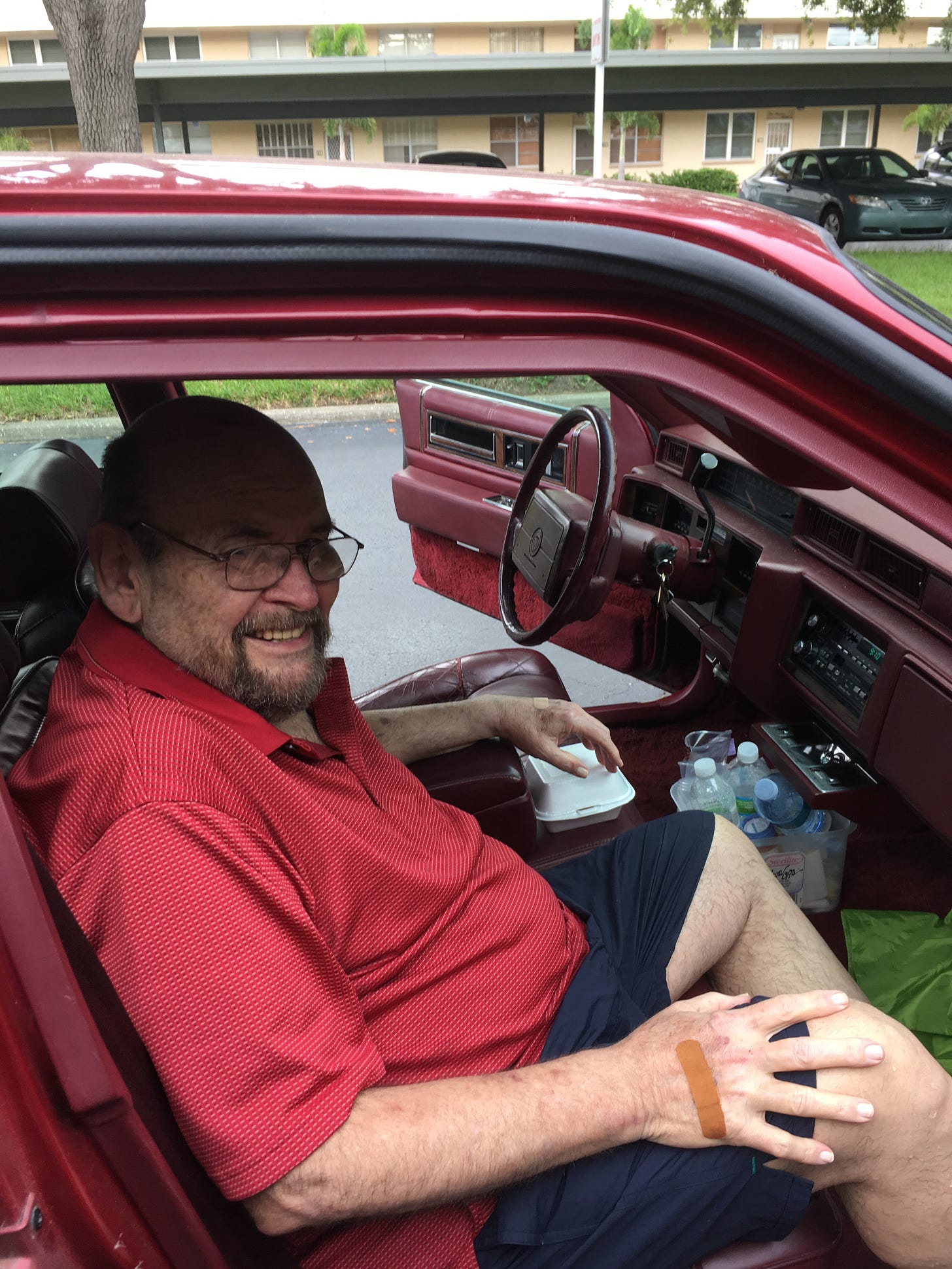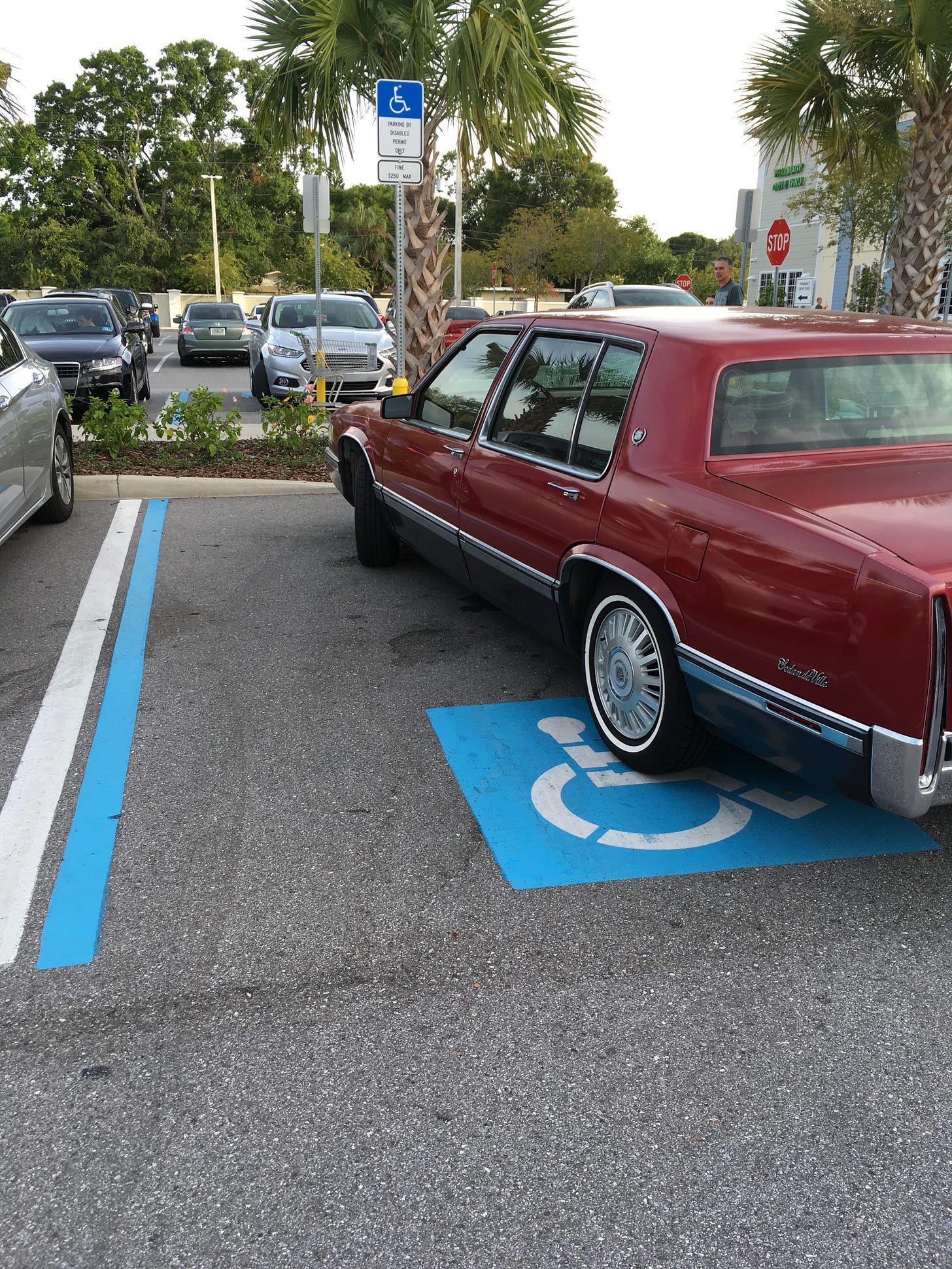Is your parent still driving? How to help them be safer before it's time to hand over the keys
There are things you can do to make sure your parent is safe driving in their later years and conversations you need to have before they become unsafe.
My father decided on his own, in his 70s, to stop driving. It happened gradually at first and then all at once.
His car was a Cadillac the color of a can of Coke. He’d bought it from a friend whose father had also loved it for decades. Its dark red leather interior and luxury touches seemed ahead of its 1991 model date.
For years, he drove his friends around. When my mom’s best friend, Terry, was struggling with anxiety and insomnia, she called my dad at all hours, and he drove to her house, opened the heavy car door for her, and drove her all over St. Pete, up the bumpy brick streets next to Coffee Pot Bayou, down sleepy First Street, and past the mangroves on 62nd, looping back down 4th Street to her house once she felt less panicked.
He drove the other older folks who lived in his complex to dinner, to the horse track, to the theater. He thought of himself, and everyone else thought of him, as capable and independent.
When I went to dinner with him, he often drove. At some point, he began to ask me to drive his car. He didn’t want to ride in my small, decidedly not luxurious car, but he didn’t want to drive. So I got behind the giant wheel of the Daddy Caddy. He still drove himself to buy groceries, and to doctor’s appointments, but if I was there, I would drive. Before long, he stopped driving anywhere other than Publix. When he discovered Instacart, he stopped driving anywhere at all.
When he completely stopped driving, he wanted to stop paying for car insurance. If you don’t have car insurance, you can’t have a driver’s license, so he asked me to take him to the DMV to trade in his drivers license for an ID card.
He was nostalgic, wistful, and sad when we went.
“I started driving at 14,” he said. “So that’s more than 60 years now.”
“At 14?” I said. “Was that legal back then?”
“Well, who was going to stop me in Pinckneyville?” he asked, laughing about the small Illinois town in which he’d grown up.
We sat next to each other on the hard plastic chairs in the waiting area. I told myself not to play on my phone, to be present with him in the moment. He stared ahead but absentmindedly touched his cane every other minute to make sure it was still there.
He must be on some kind of medication that makes his hair grow, I thought. It was wild and fuzzy where it had once been smooth. My entire life, he’d been bald on top with a ring of hair around the bottom and sides, like a horseshoe around his head. Once, in a community theater review in the newspaper, he was described as a “tall Danny DeVito.” My dad, who was at least three inches shy of six feet, was thrilled.
When the announcement system called our number, we headed to the counter. My dad couldn’t help but try to engage the DMV clerk with his nostalgia, too.
“I got my first license in 1958,” he told her. She gave him a tight, uninterested smile.
I turned to him. “If you started driving when you were 14, that would be 1954?” I said.
“Oh, yes, but I didn’t have a license until ‘58!” he laughed.
I stared at his license. I touched the top of his head. “You have more hair now than you did in this photo,” I said.
He laughed again. He ran his fingers over his hair and then the cane again.
“License, sir?” the clerk asked dispassionately. He took one last look at it and handed it over. She handed back the ID card. I drove him home in my Prius.
For some elderly people, it’s like that. They know they should stop driving. They have a close call—nearly rear-ending someone, skidding to a stop at a light, maybe getting a ticket for driving the wrong way down a one-way street. They decide they’re done. For others, it’s more complicated.
When you turn 16, getting your license and your first car is important as a rite of passage. In nearly every teen movie ever made, driving equals freedom. Stopping driving, then, is symbolic of the end of freedom. And it’s not just symbolic—driving is the key to independence. Many of us live in places that lack public transit options, especially options that are accessible for older people, and driving is essential to maintaining a quality of life. I wish I had thought more carefully and sensitively about what stopping driving meant for him.
My dad giving up his license wasn’t just symbolic to him, it was symbolic to me, too. He would be more dependent on me now. Most of the time when your parent shifts from parenting you to being dependent on you, you don’t quite notice. But when it comes to driving, you can’t ignore it. They used to buckle you into your car seat, drive you to school, drop you off at the movies. And now, here they are, sitting in the passenger seat, riding along.
Here are some ways to start talking about driving with your parent, some more direct than others:
“Hey Dad. I’m thinking I might need new glasses. Do you like your eye doctor? When’s the last time you went?”
“Mom, I think I should drive on Thanksgiving so you don’t have to drive on such a busy day on the highway. What time do you want me to pick you up?”
“My friend’s mom just got into an accident, and she was terrified. She decided to take a drivers safety course before she got back to driving. And her insurance premium actually went down after she completed it. Is that something you’d be willing to do?”
“Let’s take an Uber. I’ll show you how to do it on your phone, it’ll be fun. Have you ever thought about how you’ll get around someday if you decide to stop driving?”
“I’m getting a little worried about you driving. Have you thought about what we can do to make driving safer for you?”
“I’ve noticed you getting lost a little more, and running a couple red lights. I’m wondering why you think that’s happening? How can I help?”
If your parent is still driving, here are a few things you can do to make sure they are as safe as possible:
Check out this list of signs your parent might be less safe while driving, and ride along with them to see if any of these warning signs are present. See how you feel in the car with them, and notice whether they seem comfortable.
Encourage them to take a drivers safety course for seniors, like the ones offered online by the AARP or AAA. Completing one of these courses may even lower their insurance premium, so it’s worth calling (or online chatting) their car insurance company to find out.
Encourage them to complete a self-assessment of their driving skills, like this one from AAA.
Help them get frequent eye exams and new glasses or contacts when appropriate.
Help them get their hearing checked and encourage them to get hearing aids if necessary. (Did you know you can get hearing aids over the counter now?)
Check whether any medications they’re taking might affect their driving ability. If you go with your parent to the doctor, ask the doctor whether they think it’s okay for your parent to drive after taking their medication.
If they’re in the market for a new car, do some research so you can provide them with information about key safety features. Many new cars come standard with lane and brake assist, and the technology is changing all the time.
Discourage them from driving during high-traffic periods, for long stretches, at night, or in inclement weather.
Assess whether your parent is using the technology in their car effectively. Do they know how to use the map function, if there is one? Do they know how to turn their phone to driving mode? Are all the safety features enabled?
If you feel like it’s time for your parent to stop driving, here are a few things to do:
Have a conversation about stopping driving with your parent. Discuss how they will maintain some independence and create a plan for their transportation to social events, errands, and doctor’s appointments. Begin researching alternative transportation options. Will your parent be able to use Uber or Lyft? Are there buses or trains in your area?
If they might be able to use Uber or Lyft, consider doing a few rides with them so they get comfortable with the process. Be aware that drivers won’t help your parent in and out of the car, and many don’t have the space for a wheelchair or walker.
My dad’s health insurance covered van rides to and from doctor’s appointments, booked 24 hours in advance. Check whether your parent’s health insurance might offer a similar benefit.
Decide what to do with their car or cars. Will someone in the family need them? Will you sell them? Find the title and registration.
Research what to do in your state regarding registration, plate, insurance, and license. In Florida, we needed to surrender my dad’s license plate when we stopped paying his registration and insurance. Without insurance, he needed an ID card, not a license.
In case you missed it:
I recently shared advice on how to know when you should step in and how to track your parent’s difficulties managing the activities of daily living. Hop over to that post for the list of questions you can ask to gauge your parent’s current abilities and to download the free tracker.




"They used to buckle you into your car seat, drive you to school, drop you off at the movies. And now, here they are, sitting in the passenger seat, riding along." ✨
And the "Daddy Caddy" sounds like a helluva vehicle.